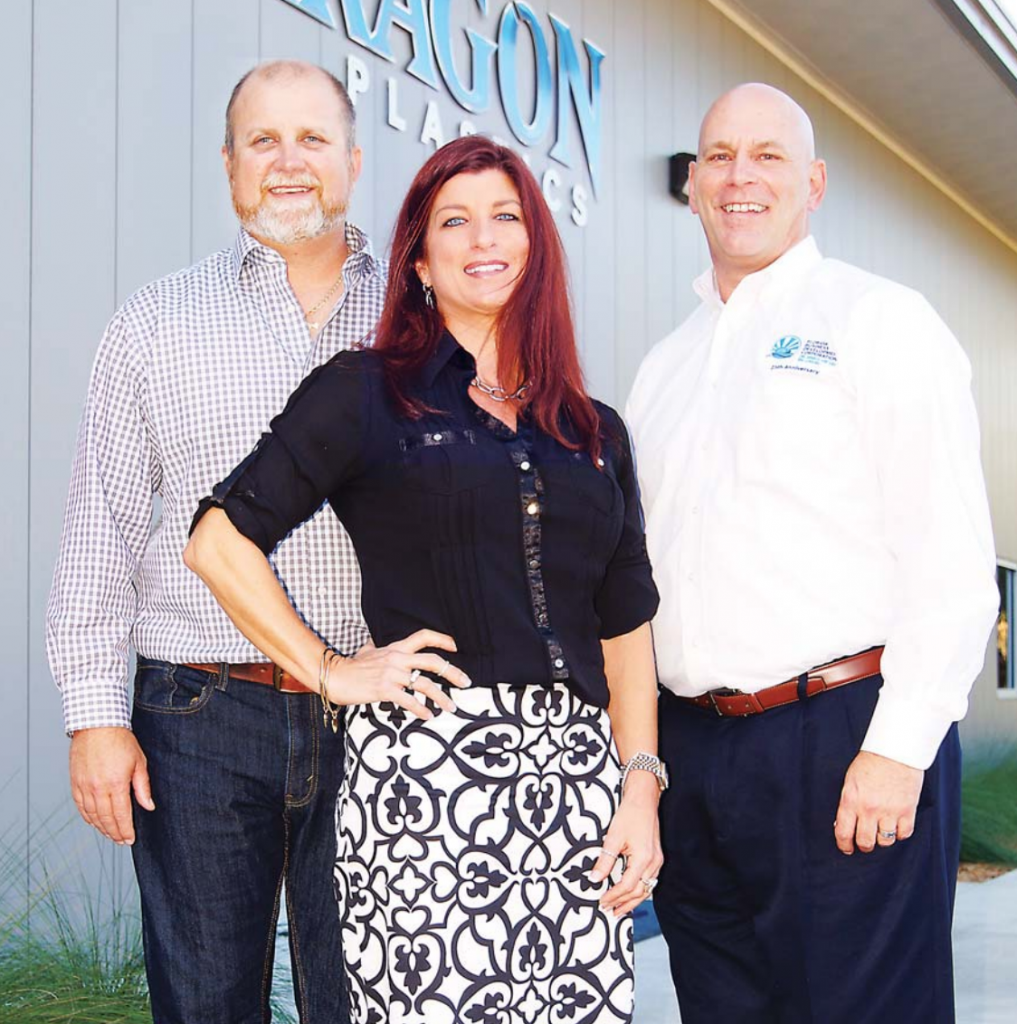TITUSVILLE— Manufacturers in Brevard County are optimistic as they look to the future, and their feelings mirror the national sentiment in their industry.
The National Association of Manufacturers’ Outlook Survey for the fourth quarter of 2017 shows that optimism among manufacturing businesses has “risen to unprecedented heights,” amid the legislative progress made on tax reform.
Locally, Paragon Plastics Inc., a leader in custom–plastic thermoforming, is scaling new heights as a private venture with the investment of a new multimillion–dollar facility.
Paragon Plastics is an example of Titusville’s revitalization momentum that continues to attract businesses to the North Brevard city.
The company’s new 67,000–square–foot manufacturing plant on Armstrong Road in Spaceport Commerce Park, situated on a six– acre parcel, is humming with production activity, turning sheets of plastic into components for a growing customer list. The company works with various materials, including fire–retardant plastics, acrylic, and polycarbonate.

Manufacturer Paragon Plastics is operating from a newly constructed 67,000–square–foot facility in south Titusville. The growing company employs 72 people. The firm was started by entrepreneur David Trout. His business was able to expand to Titusville and build a new facility through an SBA 504 loan, which requires 10 percent down and offers below–market, fixed– rate financing. Florida Business Development Corp. partners with area banks in the program. From left: Trout; Valia Rich, Regions Bank; and Tim Cramer, Florida Business Development Corp.
“Our current customers have gotten stronger and stronger as the economy has rebounded, and we’ve picked up some new customers along the way,” said businessman David Trout — the founder, president, and CEO of Paragon Plastics — whose company employs 72 people and manufactures marine products and industrial products.
Paragon Plastics does not have a product line of its own. It mainly produces products for original equipment manufacturers. Its biggest customer is boat–maker Correct Craft in Orlando. Growth has been strong for Paragon Plastics.
“We have been growing about 20 percent year–over–year, and that’s what we’re forecasting for 2018,” said Trout, who started his business in the early 1990s, after working for Sea Ray Boats Inc. on Merritt Island.
“I met a former NASA employee who had some machinery in his garage. That relationship is what got me started in manufacturing.”
He added, “For the first year or two, I did not have any employees at Paragon Plastics. I ran the business by myself, and it grew in stretches. The first employee I hired is still with the company.”
Paragon Plastics began producing “vacuum–formed flanges” and transition boxes for marine air–conditioning units.” Trout worked out of a small garage.
“Paragon Plastics is a great success story,” said Tim Cramer, the executive vice president for the Central Florida and North Florida Regions for the Florida Business Development Corp.
“I have watched David’s company evolve through the years. It’s incredible seeing the progress it has made and where it is today. He’s creating jobs, and that’s what small businesses can do if they have access to capital to expand their ventures.”
And Cramer’s company, along with Regions Bank, helped play a role in Paragon Plastics’ ability to acquire financing to grow the business and move into a new facility. Paragon Plastics invested about $3 million in its new facility, purchased new equipment, and grew its employee base.
Nearly 30 years old, the Florida Business Development Corp. assists healthy, growing companies like Paragon Plastics secure long–term, below–market, fixed–rate financing for the acquisition and development of fixed assets.
The vehicle to do this is through the U.S. Small Business Administration’s 504 lending program. That program has been helping entrepreneurs fulfill the American dream for more than three decades. With a 504 loan, an entrepreneur can purchase real estate or machinery for his or her company. They get the tax benefits and appreciation on the real estate while locking in occupancy costs for 20 years.
Because of the low down payment and other appealing features, Cramer said the 504–loan program deserves serious consideration when small–business owners are looking for financing to expand current facilities, purchase commercial real estate, or refinance an existing loan.
The 504 loans are available through “Certified Development Companies” like Florida Business Development Corp., which is a SBA community–based partner for the program.
A CDC is a private, nonprofit corporation set up to contribute to the economic development of communities. Cramer’s organization works with the SBA and private– sector lenders to provide financing to small businesses. There are more than 270 Certified Development Companies nationwide.
Florida Business Development Corp. is the largest CDC in Florida and among the top in the nation, based on funding volume.
“Our goal is to be the No. 1 CDC in the nation. We’ve been close in past years. The Florida market for 504 loans has come back strong for us since 2014,” said Cramer, who works closely with a number of area banks as 504 partners.
On the day of this interview, he had just received three 504 loan approvals for different projects by small businesses. “It’s exciting to see small businesses grow.”
His company has offices in Orlando, Tampa, Miami, and Jacksonville, as well as in Georgia and Alabama. Business has been good. Florida Business Development Corp. recently hired another business–development professional. Brock Butler, a vice president, works the Orlando market for Florida Business Development Corp.
Most companies that qualify as small businesses can qualify for a 504 loan.
“The 504 is a really attractive program for small businesses,” said Valia Rich, a business banking relationship manager with Regions Bank in Melbourne. “We partner with Tim’s organization in the 504 program. The 504 entails 50 percent on the first mortgage and 40 percent on the second mortgage through the SBA. The owner’s cash injection is 10 percent. We do a lot of 504s; the 10 percent down really appeals to small–business owners.”
Regions Bank is one of the top SBA lenders nationwide, based on loan volume and dollar volume, according to SBA statistics. “SBA lending is one of our niches,” said Rich. “We have provided a lot of SBA loans over the years for small businesses in Brevard County. The demand right now is strong.”
The 504 has three components: a direct commercial loan from the private sector, like Regions Bank, covering 50 percent of the project, and secured by a second lien; a loan secured with a junior lien from a Certified Development Company, such as Florida Business Development Corp., covering up to 40 percent of the cost and backed by a 100 percent SBA–guaranteed debenture; and a contribution of 10 percent equity from the business.
“When you’re a small business, cash is always king. The 504 program allows you to put 10 percent down versus the typical 20 percent for this type of loan,” said Trout, whose company is projected to do about $8 million in sales this year, based on a business plan forecast. The maximum gross debenture cannot exceed $5 million for regular 504 loans.
In fiscal year 2017, the 504 program grew to $5 billion in loan volume, according to the SBA. Lending to women– owned businesses, which reached $955 million, increased $277 million over the previous fiscal year.
The 504 program can also be used to refinance debt associated with fixed assets, said Cramer. “It’s now a permanent program with the SBA.” Small–business owners now have more options to refinance eligible fixed assets and business expenses through the program. It enables businessowners to obtain long–term fixed rates and potentially tap the liquidity within their commercial real estate.
The “504 Refi” program can help small–business owners increase cash flow and reduce monthly payments, for example. The SBA made the refinance program permanent last year, moving it up from a temporary status. This change will help small–business owners ease their financial burdens and create incentives for potential expansion and further job creation.
On Dec. 18, 2015, Congress passed the “Consolidated Appropriations Act of 2016,” which made the 504 Debt Refinancing Program a permanent part of the 504 initiative. It was originally a temporary program that came out of the Small Business Jobs Act of 2010.
“What’s great about the permanent ‘504 Refi’ program this time around is the banks that have the loans can refinance their own loan. The temporary refinance program didn’t have that feature,” said Cramer.
The commercial real estate has to be owner–occupied. “We do not do investment properties,” he said. In the Orlando area, Cramer’s company recently provided refinancing for three different golf courses. “It was one loan under the 504 Refi program. The bank took advantage of it because it lowered their exposure. It gave the customer a great fixed rate for 20 years. They were on a five–year note that would have kept renewing and the rate would have kept renewing. Golf courses have come back since the recession and many of them are seeing good business.”
Under the regular 504 program, Cramer is doing a loan for a new Burger King in Ocala. “That’s our third one for this particular customer.” In Daytona, Cramer is doing a new self–storage unit for a 504 customer.
“The 504 business has been great for our company. There are a lot of commercial construction projects going on in communities. The commercial real estate market is strong.” Cramer added, “People are now buying existing 504 properties, and that’s a good thing. It shows they believe in the product. And the rates are very attractive.”
Paragon Plastics previously operated in 35,000 square feet of manufacturing and warehouse space on St. Johns Street in Cocoa, not far from Cocoa Village. It had two buildings side–by–side. One building contained 20,000 square feet and the other 15,000 square feet. Also, the company leased a smaller facility in Cocoa to help with the overflow of their existing work.
Years ago, Paragon Plastics took a 504 loan for one of its main buildings in Cocoa, “and it worked out great, so I was familiar with the program,” said Trout.
Trout said the new facility “is a big step up for the company. And we have more things in the works. What we’re looking to do is purchase 4 acres next door to us and perhaps build a 25,000–to–30,000 square–foot warehouse facility. We’re okay with our manufacturing space. We just need more warehouse space.”
As a manufacturer, Paragon Plastics holds ISO 9001 certification. It’s the most widely recognized quality management standard in the world.
The Economic Development Commission of Florida’s Space Coast, the North Brevard Development Zone, the City of Titusville, and Brevard County all helped to make the expansion possible for his company.
“We were given a grant to build the facility and move into it based on the number of employees we were bringing to Titusville and the amount of growth we going to have,” said Trout. “We received great support from the county commissioners, the city council, and other organizations.”
“Providing Paragon Plastics perks for job creation is a win–win for all parties involved,” said Cramer. “Titusville did a good job bringing Paragon Plastics here,” said Rich.
Paragon Plastics was named the EDC’s 2016 “Manufacturer of the Year.” The award recognizes a Brevard manufacturer that has made or announced a significant investment in the county through job creation or retention, new capital investment and new construction.
“The EDC is a huge asset to this county, speaking from a small–business owner’s standpoint,” said Trout. “We’re thrilled to be manufacturing in Titusville and be part of the community. We see 2018 as another year of growth for Paragon Plastics.”
The post SBA 504 program helps Paragon Plastics expand with new plant in Titusville appeared first on Florida Business Development Corporation.





















